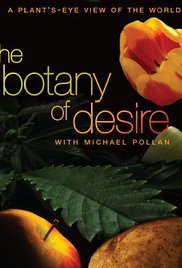Book: The Botany of Desire
Par Eric Antoine Scuccimarra I have read and enjoyed a couple other books by Michael Pollan, but was not expecting this one to be as enjoyable as it was. Humans tend to see ourselves as separate from nature, and mostly above nature. This book puts a little spin on that point of view by describing things from the perspective of plants. The book focuses on four plants: apples, tulips, marijuana and potatoes - and describes how those plants have taken advantage of human beings to further their own self-interest.
I have read and enjoyed a couple other books by Michael Pollan, but was not expecting this one to be as enjoyable as it was. Humans tend to see ourselves as separate from nature, and mostly above nature. This book puts a little spin on that point of view by describing things from the perspective of plants. The book focuses on four plants: apples, tulips, marijuana and potatoes - and describes how those plants have taken advantage of human beings to further their own self-interest.
The biggest surprise for me in reading this book was the chapter about apples. It turns out that naturally apples are quite different from the apples we eat. They are small and apparently don't taste very good. It turns out that most farmed apples are grafts of a very small number of trees. This means that when a tree naturally occurs which has palatable fruit, the tree is essentially cloned. So out of all the millions of apple trees in the world there are really only a handful of genetically distinct trees.
Apple trees are not native to North America and were brought over by European settlers. Back then apples were mainly used to make alcoholic apple cider as they didn't taste good or sweet enough to be eaten off the tree. Apple trees were not adapted to survival in North America, but as the seeds were spread around by settlers they quickly evolved to be able to survive. This was aided by people like John Chapman, better known in the US as Johnny Appleseed, who seeded apple orchards in various areas as the European settlers spread west through North America, and who serves as the thread tying the chapter together.
While humans tend to think that we control everything, in fact humans and plants coevolve, as every chapter in the book explains. Potatoes originate from South America and their spread to Europe enabled humans to multiply far beyond the restrictions of the grains which served as the primary source of calories for Europeans before the potato was introduced. Apparently there was a backlash against the potato in places like Ireland, where it allowed families to grow enough food to feed themselves and not have to participate in the economy to make money to buy food to feed themselves. It also allowed the population to grow rapidly, but since there was basically a monoculture of potatoes, when a disease arose which infected that one species of potato that predominated, it caused the potato famine which affected millions of Irish.
The potato chapter is largely about a new GMO potato which produces its own pesticide. While reading this chapter my views on GMO swung from one extreme to the other. At first I thought GMOs were not safe, but after reading about how much pesticides and herbicides potato farmers must spray onto non-GMA potatos (enough that they won't even eat their own potatoes) I started to think maybe it wasn't such a bad thing. In the end, Pollan neither eats his own garden-grown GMO potatoes nor does he feed them to anyone else, not wanting to take the chance of exposing them to unknown risks.
This was a delightful and very interesting book, and I highly recommend it.
Libellés: books